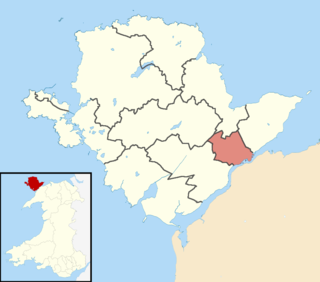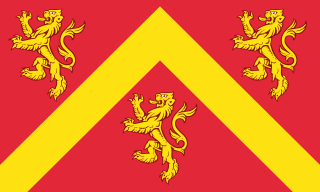Plaid Cymru is a social-democratic political party in Wales advocating Welsh independence from the United Kingdom within the European Union.

Gwynedd Council is the governing body for the principal area of Gwynedd, one of the subdivisions of Wales within the United Kingdom. The Council administrates internally through the medium of Welsh.
Welsh Labour is the part of the United Kingdom Labour Party that operates in Wales. Labour is the largest and most successful political party in modern Welsh politics, having won the largest share of the vote at every UK General Election since 1922, every Welsh Assembly election since 1999, and each European Parliament election from 1979 until 2004, as well as the 2014 one.

The National Assembly for Wales election 2011 was an election for the National Assembly. The poll was held on Thursday, 5 May 2011 and decided the incumbency for all the assembly's seats. It was the fourth election for seats in the National Assembly for Wales, and the second election taken under the rules of the Government of Wales Act 2006.

The 2012 United Kingdom local elections were held across England, Scotland and Wales on 3 May 2012. Elections were held in 128 English local authorities, all 32 Scottish local authorities and 21 of the 22 Welsh unitary authorities, alongside three mayoral elections including the London mayoralty and the London Assembly. Referendums were also held in 11 English cities to determine whether or not to introduce directly elected mayors.

An election to Ceredigion County Council was held on 3 May 2012 along with elections to 20 of the other 21 local authorities in Wales, community council elections in Wales and other elections elsewhere in the United Kingdom. It was followed by the 2017 election.

The 2013 United Kingdom local elections took place on Thursday 2 May 2013. Elections were held in 35 English councils: all 27 non-metropolitan county councils and eight unitary authorities, and in one Welsh unitary authority. Direct mayoral elections took place in Doncaster and North Tyneside. These elections last took place on the 4 June 2009 at the same time as the 2009 European Parliament Elections, except for County Durham, Northumberland and the Anglesey where elections last took place in 2008.

The 2017 Scottish local elections were held on Thursday 4 May, in all 32 local authorities. The SNP retained its position as the largest party in terms of votes and councillors, despite suffering minor losses. The Conservatives made gains and displaced Labour as the second largest party, while the Liberal Democrats suffered a net loss of councillors despite increasing their share of the vote. Minor parties and independents polled well; and independent councillors retained majority control over the 3 island councils. For the first time since the local government reforms in 1995, all councils fell under no overall control.
The fifth election to the Carmarthenshire County Council was held on 1 May 2012. It was preceded by the 2008 election and was followed by the 2017 election. Plaid Cymru won 28 seats whilst Labour and the Independents won 23 each. The main feature of the election was a Labour recovery in the Llanelli area, and to some extent in the Gwendraeth and Ammanford area also, mainly at the expense of Independent candidates. Plaid Cymru lost ground to Labour in the Llanelli area but gained seats elsewhere, becoming the largest party. An Independent-Labour coalition was again formed, but with Labour as the leading partner. As a result, Kevin Madge replaced Meryl Gravell as the leader of the council.

The 2017 United Kingdom local elections were held on Thursday 4 May 2017. Local elections were held across Great Britain, with elections to 35 English local authorities and all councils in Scotland and Wales.

Local elections were held in Wales on Thursday 4 May 2017 to elect members of all 22 local authorities, including the Isle of Anglesey, which was last up for election in 2013 due to having its elections delayed for a year. These local elections were held alongside local elections in Scotland and parts of England.
The Isle of Anglesey electoral boundary changes in 2012 reduced the numbers of electoral wards to the Isle of Anglesey County Council from 40 to 11. This led to the postponement of local government elections in the county by 12 months. The changes were confirmed by the Isle of Anglesey Order 2012 in October 2012.
The 2008 Isle of Anglesey Council election took place on Thursday 1 May 2008 to elect members of the Isle of Anglesey County Council in Wales. This was the same day as other United Kingdom local elections. The previous full council election was on 10 June 2004 and the next full council election was held on 2 May 2013.

Canolbarth Môn is an electoral ward in the centre of Anglesey, Wales. It includes the communities of Bryngwran, Bodffordd, Llangefni, and Trewalchmai, and the majority of Llanddyfnan. Canolbarth Môn elects three county councillors to the Isle of Anglesey County Council.

Bro Aberffraw is an electoral ward in the southern corner of Anglesey, Wales. It comprises the three communities of Aberffraw, Bodorgan and Rhosyr. Canolbarth Môn elects two county councillors to the Isle of Anglesey County Council.
The 2017 Isle of Anglesey County Council election, to the Isle of Anglesey County Council was held on 4 May 2017 as part of the United Kingdom local elections, 2017. All 30 council seats were up for election. The previous full election took place in 2013 and the next one is scheduled for 2022.
The 2004 Isle of Anglesey County Council election took place on Thursday 10 June 2004 to elect members of the Isle of Anglesey County Council in Wales. This was the same day as other United Kingdom local elections. The next full council election was on 1 May 2008.

Aethwy is the name of an electoral ward in the south of Anglesey, Wales, created in 2012. It contains the population centres of Menai Bridge and Llanfair PG.
Ynys Gybi is the name of an electoral ward in the west of Anglesey, Wales, created in 2012. It covers the most part of Holy Island, whose name is Ynys Gybi in Welsh.













